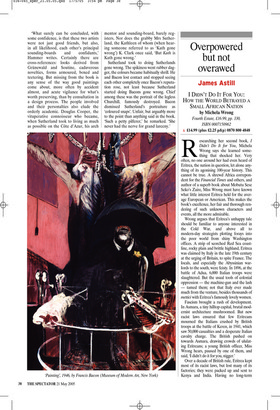Not a matching pair
William Feaver
BACON AND SUTHERLAND by Martin Hammer Yale, £25, pp. 272, ISBN 0300109067 Horny black hills on red grounds and exposed roots clawing the air like scary glove puppets are typical of Graham Sutherland in his prime. Teeth and thorns, the odd crucifixion and Somerset Maugham perched on a rattan stool with a jaundiced tortoise look on his face are typical of him soon after, in the Forties, when he and Bacon became friends and their work came close to colliding.
Similarities between the two painters are mustered in a colour-plate section at the beginning of an unbelievably circumspect book. ‘This account proceeds,’ the author explains, ‘from the specifics of an interchange between two individuals to considering more general frames of reference within which their affinities and differences may be usefully considered.’ Bacon’s response to that ‘usefully’ would have been a heartless cackle.
Martin Hammer sets out his stall with the caution of a lecturer suddenly called upon to operate two slide projectors at once. ‘Before looking at the evident visual affinities of the work that the two artists produced in the years 1943 and 1944,’ he warns his audience, ‘I want to step back somewhat, and adjust the focus from Bacon to Sutherland.’ While Hammer twiddles his critical apparatus it’s worth mentioning, maybe, that Sutherland himself referred to ‘the habit of art historians to oversimplify to label and pigeonhole’. Booked into a double pigeonhole, he and Bacon become an odd couple brought together by art historical imperatives: the magnetism of ‘influences’ and the atmospherics of culture. This isn’t to say that the two were unaffected by one another. There was a friendship and, as the pictures show, there were for a while stylistic parallels and overlaps. The differences, however, were fundamental.
Sutherland was essentially a graphic artist. Unlike Bacon he enjoyed the patronage of Kenneth Clark, who included him in the series Penguin Modern Painters, a distinction equivalent to about five Turner Prizes. Having trained as an illustrator at Goldsmiths, alongside Rowland Hilder, the Canaletto of the Kent cherry orchards, he had found himself, spiritually speaking, in the creeks and hills of Haverfordwest; but he didn’t go abroad properly until 1944 when, as an Official War Artist (thanks to K. Clark) he drew railway yards in northern France. Bacon, six years his junior, already knew his way around in the late Twenties, around Berlin especially. Both of them assimilated — as painters do Picasso being the most obvious stimulus, though Sutherland also went a bundle on Samuel Palmer.
Sutherland’s wartime manner (usually labelled ‘neo-romantic’) was fully developed well before Bacon came out as a notable painter with his ‘Three Studies for Figures at the Base of the Crucifixion’ of 1944 in which victimised body parts are showcased in a setting the colour of Ministry of Health concentrated orange juice. Meeting Bacon was an eye-opener for Sutherland. Here was a rawness that he with his draughtsman’s training could only envy or emulate. ‘What surely can be concluded, with some confidence, is that these two artists were not just good friends, but also, in all likelihood, each other’s principal sounding-boards and confidants,’ Hammer writes. Certainly there are cross-references: looks derived from Grünewald and Soutine, cadaverous novelties, forms armoured, boxed and teetering. But missing from the book is any sense of the way good paintings come about, more often by accident almost, and acute vigilance for what’s worth preserving, than by consultation in a design process. The people involved and their personalties also elude the orderly academic. Douglas Cooper, the vituperative connoisseur who became, when Sutherland took to living as much as possible on the Côte d’Azur, his arch mentor and sounding-board, barely registers. Nor does the grabby Mrs Sutherland, the Kathleen of whom (when hearing someone referred to as ‘Kath gone wrong’) K. Clark once said, ‘But Kath is Kath gone wrong.’ Sutherland took to doing Sutherlands gone wrong. The spikiness went rubber dagger, the colours became habitually shrill. He and Bacon lost contact and stopped seeing each other completely once Bacon’s reputation rose, not least because Sutherland started doing Bacons gone wrong. Chief among these was the portrait of the legless Churchill, famously destroyed. Bacon dismissed Sutherland’s portraiture as ‘coloured snaps’. Unfair, but arguably more to the point than anything said in the book. ‘Such a petty pilferer,’ he remarked. ‘She never had the nerve for grand larceny.’


























































 Previous page
Previous page